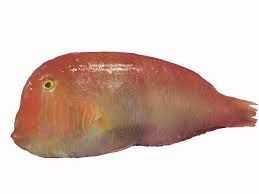Pearly Razorfish

Species Details
Xyrichtys Novacula
Labridae
Perciformes
Inshore
1 - 1 lbs.
5" - 8"
Pearly Razorfish (Xyrichtys novacula) Fish Description
The Pearly Razorfish, also known under the names of the Cleaver wrasse, Razor wrasse, Sand wrasse, and the Razorfish.
They are often found yellow-orange or reddish-pink in color, with a darker gradient on top and lightening towards their undersides, that is marked with green-grey stripes. They have elongated and laterally flat bodies, as they are very compressed with their head flattened as well, with a steep profile and sharp teeth. Their head shows narrow light blue vertical lines, and they have scales with brisk reflexes on their stomachs. Pearly Razorfish has a long dorsal fin extending through most of its back, with 9 dorsal spines and 12 dorsal soft rays. And that they also have 3 anal spines and 12 anal soft rays.
Pearly Razorfish Diet & Size
Pearly Razorfish diets include feeding on small invertebrates, like crustaceans, mollusks, and echinoderms. Pearly Razorfish can grow in length reaching up to 15 in, though most of them do not exceed 7.9 in.
Interesting Facts about Pearly Razorfish
- Pearly Razorfish, when disturbed, buries themselves briskly in the bottom to take cover.
- When a Pearly Razorfish faces capture, they are known to turning their mouth and sharp protruding teeth up to a 90-degree angle (in relation to their own body) at either side to evade capture.
- The Pearly Razorfish is known to have a playful demeanor, especially among divers.
- The Pearly Razorfish is apparently a protogynous hermaphrodite.
- Not many people capture this fish because there's not much use for it in cuisines.
Pearly Razorfish - Fishing Techniques
When shore fishing for Pearly Razorfish, also known as Wrasse, they can be caught using a wide variety of baits, such as sand eels, small pieces of fish like herring, mackerel, squid, etc. But it is preferably best to try small crustaceans such as prawns, peeler crabs, and softback crabs.
Remember to stay close to clear, shallow waters of around 1-20m deep, with sandy or rocky bottoms as these are where they prefer to inhabit during the summer. Rock Bottom Rigs would be ideal when fishing for the Pearly Razorfish. Be patient and try not to cause a commotion, lest these fish would be too intimidated and will bury themselves into hiding. And when caught, try to avoid getting your lines entangled, because they will try and entangle them somehow within the rocks. Last but not the least, be careful! Because they have very sharp teeth and can angle their heads up to 90-degrees at either side and can take a mean bite right at you.
Pearly Razorfish Habitat and Distribution
Pearly Razorfish can be observed inhabiting clear, shallow areas with sandy or muddy bottoms, at depths between 1 to 20m., but they go ever deeper into the water during winter, at around 90 to even 150m. You can find their behavior to be very shy, and suddenly disappearing, by burying themselves in the sand when they’re overwhelmed.
They are widespread and found throughout the Atlantic Ocean, distributed in the western Atlantic from North Carolina all the way up to Brazil, and including the Gulf of Mexico and the Caribbean Sea. In the east of the Atlantic, they can be found ranging from the southern coast of Spain, all across the Azores, Madeira, Cape Verda, and São Tomé all the way to Gabon. And that they can also be found as well in the Mediterranean Sea.







